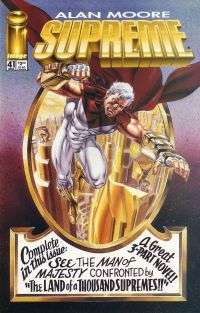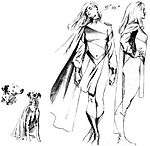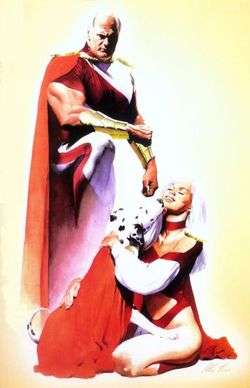Supreme (comics)
| Supreme | |
|---|---|
|
Supreme, Suprema, and Radar Art by Alex Ross | |
| Publication information | |
| Publisher |
Image Comics Maximum Press Awesome Entertainment Arcade Comics |
| First appearance | Youngblood #3 (October 1992) |
| Created by | Rob Liefeld |
| In-story information | |
| Alter ego | Ethan Crane |
| Team affiliations |
Brigade Heavy Mettle Allied Supermen of America The Allies The Supremacy |
| Notable aliases | Kid Supreme |
| Abilities |
|
Supreme is a fictional superhero created by Rob Liefeld and published by Image Comics (1992–96 and 2012), followed by Maximum Press (1996–98), Awesome Entertainment (1999-2000) and Arcade Comics (2006). Although Supreme was originally a violent, egotistical Superman archetype, he was retooled by Alan Moore as a tribute to Mort Weisinger's Silver Age Superman.[1]
The character had a 56-issue comic book series, Supreme: The Return #1-6, and a revival in 2012 with issues #63-68 (Supreme: The Return's six issue miniseries counting as issues #57-62). Beginning with issue #41, Moore's run was collected in two trade paperbacks from the Checker Book Publishing Group: Supreme: The Story of the Year and Supreme: The Return. Moore's work on the series earned him a Best Writer Eisner Award in 1997.[2]
Fictional character biography
Supreme

Supreme was introduced in issue 3 of Rob Liefeld's Youngblood limited series as a flip book story, before he was spun off into his own series. His history varied; at one point, he was an angel of vengeance who quoted the Bible to justify his actions. At other times, such as when he defeated the Norse god Thor and took his mystical hammer Mjolnir, Supreme considered himself a god. Although the most powerful being in the Liefeld universe, he had his share of defeats: he was killed in the cross-title Deathmate Black series (published by Image and Valiant Comics), lost his powers in Extreme Prejudice, and was killed by Crypt in Extreme Sacrifice.
The character received a comprehensive treatment in The Legend of Supreme, a three-issue miniseries by Keith Giffen and Robert Loren Fleming. In the miniseries, reporter Maxine Winslow investigates Supreme's origin story. Winslow learns that in 1937, Ethan Crane shot and killed two men in retaliation for the rape of a 15-year-old girl. Crane was shot by two police officers, but survived and was sentenced to life imprisonment. In prison, the government offered him a chance to participate in a human-improvement experiment in the hope that (unlike the six previous guinea pigs) he would survive.
Although Crane died like the others, unlike them he returned to life in a world which was strange and new to him. He found his way to a church, where he received sanctuary from Father Beam and discovered some of his new abilities. Crane took the name "Supreme" and, hearing about the war in Europe, decided to do his part. Little was revealed about Supreme's work in World War II, except that he joined the Allies. After the war, Supreme believed that he had done his part as a good Samaritan and left Earth; in reality, Father Beam's accidental death of at his hands drove him away.
Supreme spent decades in space, fighting a number of threats on the side of an alien race known as the Kalyptans (the race of Gary Carlson and Erik Larsen's Vanguard). He returned to Earth in 1992 to find a changed society, which included genetically-enhanced superpowered humans on teams such as Youngblood and Heavy Mettle. Although Supreme was briefly the field team leader of Heavy Mettle, he left the position after defeating the villain Khrome.
When Supreme fought Thor for Mjolnir, a character named Enigma acquired another Supreme from an alternate timeline to store if Supreme was defeated. Supreme was victorious, so the other Supreme was left alone; this figured in the events of The Legend of Supreme. Although Supreme apparently died during an assault on humanity by Lord Chapel, he was stranded on an alternate Earth for several years until the alternate Supreme (stored by Enigma) returned and was defeated by the original Supreme. Original Supreme switched bodies with the alternate Supreme, restoring his powers. After several events involving Enigma and Probe (Supreme's daughter from the future, also known as Lady Supreme), the original Supreme worked with Probe, Enigma and the alternate Supreme to defeat the evil Norse god Loki (who had shifted realities). At the end of Supreme #40, Probe remained on the alternate Earth and Supreme returned to Earth.
Alan Moore's Supreme

Rob Liefeld asked Alan Moore to write for Supreme. Moore agreed on the condition that he could reinvent the character, since he felt that the comic was "not very good."[1] Beginning with issue 41 of Supreme Moore began retooling the character, with each issue containing commentary on storytelling, comics history in general and Superman in particular.[1] Clichés of the superhero genre were frequently used.[1] Moore said in later interviews that his re-imagining of Supreme's background and origin was an apology for the darkness of his previous works at other publishers; he had a reputation for the cynical deconstructing of superheroes in Batman: The Killing Joke, Hellblazer, Swamp Thing, and Watchmen.[1]
Story of the Year
Given free rein over Supreme and the wider Maximum (later Awesome) universe, Moore created a complex storyline to reinvent the Supreme universe. Drawing on Silver Age Superman and innovations by Silver Age comic artists such as Julius Schwartz, Curt Swan and Murphy Anderson, Moore wrote the "last" Silver Age Superman story (Superman: Whatever Happened to the Man of Tomorrow?) for Schwartz with Swan and Anderson and referenced Anderson in his 1963. Moore's Supreme built on and ignored the previous issues, re-creating the character from his origins. Although the "Story of the Year" arc was intended to finish with a Silver-Age-evoking 80-Page Giant special issue, it was split into two parts: 52a and 52b. The action, which included multiple flashbacks to earlier Supreme stories, pastiches of (and references to) comic-book staples, was tied together in #52. According to Liefeld, Tom Strong owed a debt to Supreme.[3]
The new version of Supreme had a secret identity as Ethan Crane, a mild-mannered artist for Dazzle Comics who received his powers as a result of a childhood exposure to a meteorite composed of Supremium, an element which can alter reality. When not saving the world as a superhero Crane illustrated the adventures of Omniman, a Supreme-like character being reintroduced with a change of writers.
Moore did not ignore the events of previous issues, but made them central to his Supreme storyline. In Moore's first issue, Supreme returned to Earth and discovered that he was living in the most-recent revision of reality (an ever-changing story) in his most-recent version. Retired Supremes lived in another reality, called the "Supremacy" by its inhabitants, which was an afterlife for characters whose stories had ended. Although Supreme first experienced amnesia, he learned that his returning memories were actually backstory. As his memories returned, the flashbacks to his childhood and previous adventures reflected the styles of different periods of comics history.
Darius Dax, a Lex Luthor-like evil genius who was Supreme's antagonist, was introduced in this storyline. Dax died twice in the series, the first time in prison from lymphatic cancer caused by exposure to Supremium.
The Return

Moore continued working on the series until Supreme #56, when it became a miniseries entitled Supreme: The Return. After six issues, the miniseries was cancelled when Awesome Comics collapsed. According to artist Rick Veitch, Moore had written an additional issue or two which were never published; Supreme: The Return's "biggest failing is that the final issue of the story was never produced. This volume takes care of that little problem by ignoring it completely and just tacking 'The End' on the last story."[1]
After Darius Dax is defeated, Supreme finds an ember of Judy Jordan's consciousness in her body and transfers it to a Suprematon android. Although Judy now has superpowers, she has trouble adjusting to another body and missing the last 20 years of her life. S-1, the only other sentient Suprematon, expresses his love for her. He changes his name to Talos, and they are married by Supreme in the Flying Citadel. They leave Earth, and find an uninhabited planet on which to live.
Ethan Crane's romance with Diana Dane falters when she becomes annoyed with the way he "gets all weird and runs away." After arranging a meeting as Ethan he tries to reconcile with her as Supreme, giving her a tour of the Citadel to give her ideas for Omniman. After a trip to the Supremacy, Diana discovers Ethan's identity and is willing to continue their relationship.
After Darius Dax becomes the Supremium meteorite at the end of The Story of the Year[4] he is sent to Daxia, a place similar to the Supremacy. Every version of Dax before him lives in Daxia, including Darius Duck, Daxor, Daxian, Doomsdax, mad Nazi scientist Dax and serial-killer, transvestite 1980s Dax. The combined intelligence of the Daxes allows him to return to the land of the living. Again trying to destroy Supreme, he sets in motion another chain of events involving Billy Friday and Master Meteor.
Announced finish
At New York Comic Con 2011, Rob Liefeld and Erik Larsen announced that the last unpublished Supreme stories would be published and drawn by Larsen.[5][6] Supreme #63 was published in 2012 by Image Comics, with Moore's final completed Supreme script.
Erik Larsen's Supreme
Erik Larsen wrote and drew Supreme for five issues (#64-68), seeing Moore's work on the title purged and Liefield's early-1990s version of the character restored. On the letter page of his first issue Larsen wrote, "My thought was to marry the two and take what Alan had done and what came before and try to find something in the middle which might appeal to both audiences.".[7]
He opened with a resurrected Darius Dax and his counterparts laying siege to the Supremacy, killing Supreme's counterparts with weapons stolen from the Supremacy's armory. Supreme the Fifth (ruler of the Supremacy and the Supreme Supreme), Radar, the hound Supreme, 90 percent of the past Supremes, and the supporting members of the Supremacy (including Billy Friday and Judy Jordan) are killed. To stop the killing spree, the surviving Supremes (Moore's Supreme, the 1950s Supreme with a lion's head, Squeak—the mouse Supreme, the 1970s Sister Supreme and the original Supreme) free Rob Liefield's original Supreme from his imprisonment. Called "mean" Supreme in the comic, his violent, bigoted and psychotic behavior led to his restraint with chains in a subarea of the Supremacy. Freed by "modern" Supreme and "original" Supreme, "mean" Supreme murders all the Darius Daxes, turns against the heroic Supremes, removes their powers with Silver Supremium and carries the Supremacy to the Moon.
Mean Supreme returns to a rebooted Earth and goes on a killing spree, murdering criminals to re-establish his position as the most powerful superhero on the planet. Diane Dane and "modern" Supreme are aware of the reboot, and she has a new life with someone other than Supreme. The Supremes try to adjust to their helplessness in ending "mean" Supreme's rampage. Ethan Crane learns that his alter ego's life is gone; he cannot find work as a comic-book artist because his talent came from his Supreme power. Larsen's run was poorly received, and ends with the Alan Moore Supreme and his allies discussing the possibility that their powered selves still exist in the Supremacy.
Villains
- Darius Dax: Supreme's arch-enemy, who (like Supreme) has been through a number of incarnations. When Darius merged with Supremium, he fell backwards in time and emerged in the past at the Crane's house, where he fought Supreme and accidently gave Sally Crane her powers, before merging with even more Supremium and falling further back in time and becoming the Supremium meteorite that gave Ethan Crane and his dog Radar their powers.
- Emerpus: Reverse Supreme from the Backwards Zone[8]
- Gorrl: Living galaxy who held Suprema captive for thirty years[9]
- Korgo (first name Brinn): Warlord from space, who defeats Bill Clinton under the rules of the Cosmic Dictators Guild and wins[10]
- Master Meteor: First appears in Littlehaven in search of the Supremium isotope[11]
- Optilux: Religious alien, who became a being of pure light with a messiah complex[10][12]
- Televillain: Television repairman who gained the ability to enter the fictional worlds of television programmes[10][12]
- The End: Powerful villain in the Hell of Mirrors[8]
- Shadow Supreme: Evil version of Supreme, created by Darius Dax's negative energy ray[10][12]
- Slaver Ant: Female humanoid ant-like creature who secretes behavior-altering chemicals[10][12]
- Vor-Em: Humanoid lion warrior[10][12]
Supremium
Supremium is the source of Supreme's power. As a child, Ethan Crane found a meteorite composed of pure Supremium, which turned his hair white and gave him various powers such as flight, invulnerability, strength, intelligence and speed.
Supreme Sacrifice
In 2006, Arcade Comics published Supreme's return in a comic by Robert Kirkman, Jon Malin and Rob Liefeld.[13]
Other versions
Kid Supreme
During World War II, Charles Flanders[14] discovered he could tap into Supreme's power and became the first Kid Supreme. The second Kid Supreme, Danny Fuller,[15] received superpowers during a fight between Supreme and Union. Alan Moore's Kid Supreme, a younger version of Supreme, is an homage to Superboy.[16]
Probe
Probe, the daughter of Glory and Supreme, is later called Lady Supreme. Although she is removed from reality by Alan Moore's retool, she still exists in the Supremacy.
Suprema

Supreme's sister, Sally Crane, became Suprema when she was exposed to Supremium.
Collections
US
Supreme #23 was reprinted in the Extreme Sacrifice trade paperback (ISBN 1-887279-06-7) in August 1995.
- Supreme Madness - Supreme #12-18 (Image Comics, 160 pages, 1996, ISBN 1-888610-06-9)
- Supreme: The Story of the Year - collects Supreme #41-52 (Checker Book Publishing Group, 2002, 332 pages, ISBN 0-9710249-5-2)
- Supreme: The Return - collects Supreme #53-56, Supreme: The Return #1-6 (Checker Book Publishing Group, 2003, 258 pages, ISBN 0-9710249-6-0)
- Supreme: The Story of the Year and The Return are available digitally from Devil's Due Digital.
- Supreme: Blue Rose - collects Supreme: Blue Rose #1-7, Image Comics, 160 pages, 2015, ISBN 1632153122
France
Licenced by Checker, using the same layout and images with a French translation:
- Suprême, Tome 1: L'Âge d'or (Delcourt Contrebande, 2004, 324 pages, ISBN 2-84789-065-3)
- Suprême, Tome 2: Le Retour (Delcourt Contrebande, 2009, 324 pages, ISBN 2-84789-219-2)
Spain
Licenced by Checker, using the same layout and images with a Spanish translation:
- Supreme, Tomo 1: La Historia del Año (Random House Mondadori, 2011)
- Supreme, Tomo 2: El Retorno (Random House Mondadori, 2011)
Germany
- Supreme: The Story of the Year, Part 1 (Nona Arte, March 2011, 152 pages, ISBN 978-88-97062-10-3)
- Supreme: The Story of the Year, Part 2 (Nona Arte, April 2011, 168 pages, ISBN 978-88-97062-11-0)
See also
References
- 1 2 3 4 5 6 J.C. Macek III 20 June 2013 (2013-06-20). "Supremium: Image Comic's Less "Awesome" Superman". PopMatters. Retrieved 2014-07-17.
- ↑ "1997 Will Eisner Comic Industry Award Nominees and Winners". Hahnlibrary.net. Retrieved 2014-07-17.
- ↑ Naso, Markisan. "Bloodletting". ComicsBulletin.com. Archived from the original on 23 May 2011. Retrieved 16 April 2015.
- ↑ Supreme #52 (1998)
- ↑ "Black Swan Screenwriter To Relaunch Youngblood, Alan Moore’s Supreme To Be Concluded With Erik Larsen, In Extreme Relaunch - Bleeding Cool Comic Book, Movie, TV News". Bleedingcool.com. 2011-10-14. Retrieved 2014-07-17.
- ↑ "Liefeld's Extreme Studios Returns With a New Alan Moore Supreme Story". Comicbook.com. Retrieved 2014-07-17.
- ↑ Supreme #64 (May 2012)
- 1 2 Supreme #51 (1997)
- ↑ Supreme #46 (1996)
- 1 2 3 4 5 6 Supreme: The Return #1 (1998)
- ↑ Supreme: The Return #5 (1998)
- 1 2 3 4 5 Supreme #56 (1998)
- ↑ "Jon Malin". Wizardworld.com. Retrieved 2014-07-17.
- ↑ Supreme vol. 2, #9 (1993)
- ↑ Supreme vol. 2, #19 (1994)
- ↑ Supreme vol. 2, #42 (1996)
External links
- Supreme at the Comic Book DB
- Supreme on Devilsduedigital.com
| ||||||||||||||||||||||||||||||||||||||||||||||
| ||||||||||
